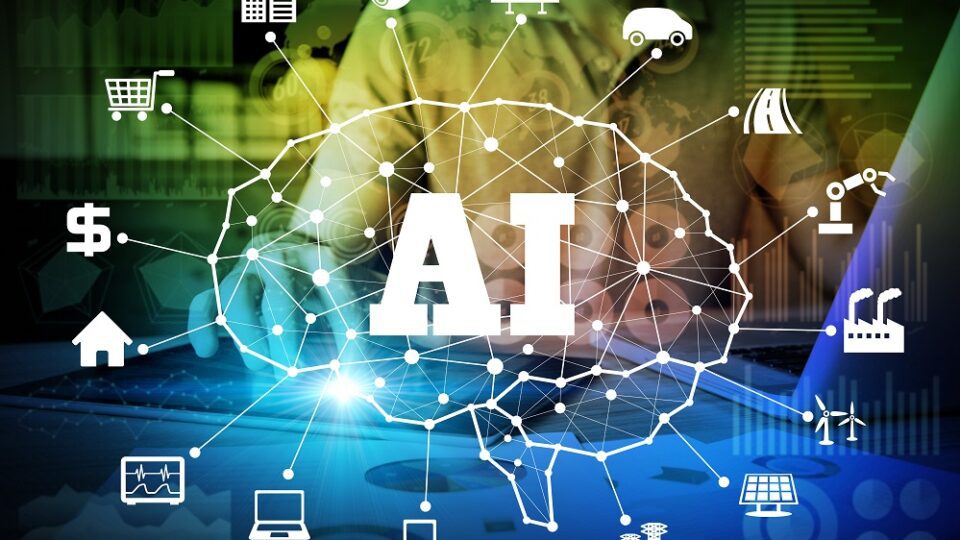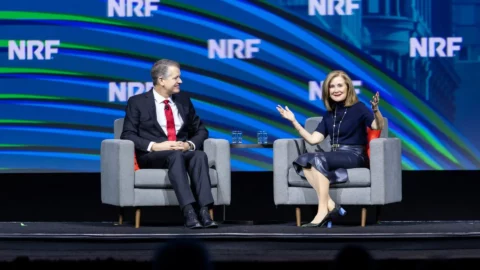Editor’s note: This is the fourth article in our series on AI in retail. Check out our other stories, on consumer attitudes toward AI, store design applications and customer-facing applications. Be on the lookout for the fifth article, which will cover the many still-unanswered questions around AI’s present and future.
The newest generation of artificial intelligence (AI) would seem to be tailor-made for the behind-the-scenes operational complexity of today’s retail organization — and in many ways it is. Generative AI-powered solutions’ ability to ingest non-linear, non-numerical types of data, including images, audio and video, is a strong fit for the multi-touch-point nature of commerce today. Additionally, AI’s ability to suggest optimal responses to challenges — like what to do if a tornado collapses the roof of a distribution center — aligns with the industry’s rapid pace and need for flexibility.
Retail is already seeing successful use cases: Albertsons recently rolled out a predictive ordering platform from Afresh Technologies designed for the rapidly changing nature of fresh products to more than 2,000 of its supermarkets, providing department managers with easy-to-use ordering tools leveraging real-time insights. The solution provider noted that grocers using its solution typically see a 3% sales increase, significant improvement in inventory turns and up to 25% less food waste — a result that would support the supermarket retailer’s sustainability goals.
Walmart is reportedly building on OpenAI’s GPT-4, according to an interview Desirée Gosby, VP of Emerging Technology at Walmart Global Tech, gave to Venture Beat, Gosby predicted that generative AI like GPT-4 will “be as big a shift as mobile, in terms of how our customers are going to expect to interact with us.” The publication also has reported on the role of AI in Walmart initiatives to enhance search, add Text-to-Shop functionality and improve its supply chain.
But any new (or newly enhanced) technology also carries risks. “With generative models of AI and ML, they are only as good as your training data, which needs to be correct, unbiased and high-quality,” said Ed Murphy, SVP of Data Science at 1010Data in an interview with Retail TouchPoints. “Additionally, generative AI models will always give you a confident response; they won’t say ‘I don’t know.’ If the environment has shifted or become uncertain, you can’t take accuracy for granted, and taking it as an unchallenged fact would be a danger.”
Can AI-Powered Supply Chains Autonomously Find and Fix Problems?
Supply chain challenges predated COVID and the Russian invasion of Ukraine, of course, but both these macro events have turned up the pressure significantly. And while experts note that AI’s value is limited when it comes to dealing with unprecedented events on this scale, they agree that these solutions bring real value.
“AI offers planners increased visibility across supply chains, enabling effective ‘sensing and pivoting’ within volatile and uncertain environments,” said Bharath Thota, Partner and Chief Solutions Officer in the Analytics practice of Kearney in an interview with Retail TouchPoints. “Generative AI functions as an enhanced cognitive engine, identifying relevant business and risk signals such as emerging customer trends, competitors’ moves, market changes or supply shortages, and suggesting appropriate adjustments in forecasts and plans in response.
“By learning from past signals and proactively guiding various supply chain segments to make the right decisions in the right sequence, generative AI moves companies closer to achieving optimal synchronization across the supply chain to cost-effectively meet demand,” Thota added. “Eventually, generative AI could update plans autonomously in real time based on sensed changes, minimizing human intervention and bias and enhancing overall responsiveness.”
MIT Professor Dr. Yossi Sheffi, author of The Magic Conveyor Belt: Supply Chains. A.I., and the Future of Work, identified AI’s consumption and use of literally millions of disparate data points as a key element of its value. When AI-powered solutions work in tandem with IoT sensors and visibility software, that value is multiplied. He gave the example of truck congestion along the U.S.-Mexico border. Seeing this, a supply chain manager would want to know exactly how this would affect the trucks carrying their company’s products.
“You would know from the GPS on the truck that there’s a problem, because the truck isn’t moving,” said Sheffi in an interview with Retail TouchPoints. “But analyzing this is where AI, especially the machine learning part of AI, can really help, with programs based on analyzing millions of movements and seeing how it would propagate in the past. It can then forecast better what might happen and offer possible mitigation strategies to deal with the problem.”
AI can help get products to the distribution center and eventually the store, and also can help make sure they don’t leave the store in a shoplifter’s hands. “Many people think that you have to make big capital investments in order to embrace AI, but that’s not the case,” said Thota. “Every retail store already has connected devices such as CCTV cameras and sensors on doors and refrigerators. If we’re able to use existing tech and capture that info, it doesn’t have to be ‘picture perfect,’ because AI tech can enhance video images.
“Generative AI is multi-modal, so it’s not just fixated on data or even words,” Thota added. “If you think about a matrix including numerical info, images, audio and video, [the question becomes] what kinds of use cases you can do connecting all of these things.”
How AI can Ease Persistent Store-Level Pain Points
The machine learning and generative aspects of today’s AI open the possibility of systems not simply analyzing conditions and making recommendations to a human but actually implementing the results of those analyses. Using AI, “retailers can start from the automated systems they’re taking over from,” said 1010Data’s Murphy, noting that AI-powered systems “can not only place a replenishment order [for a product], they could even set a new stock threshold [for ordering]. Because it’s working from much broader inputs and more advanced neural networks, AI can take into account more factors, such as competitive pricing, weather patterns and promotional cannibalization. This gives you a chance to revisit all of your decision-making continually, so rather than maintaining a set stock level, it can adjust your stock level automatically based on feedback.”
Murphy also noted that adaptive staff scheduling powered by AI “can do a better job accounting for availability and things like seasonal disease trends as well as historical outcomes, so you can see how staffing decisions actually turned out.”
Everything Comes Back to the Data
As promising as AI can be in retail operations, it also carries risks. In a sense, the biggest ones are vastly more complex versions of the old “garbage in, garbage out” computing maxim. Some of that complexity arises because of the machine learning aspects of AI, which allow solutions to iterate and (hopefully) continuously improve as they work.
Concerns about the odd directions generative AI can take were captured in a Feb. 16, 2023 New York Times article headlined “A Conversation with Bing’s Chatbot Left me Deeply Unsettled,” where the article writer revealed that the chatbot essentially tried to break up his marriage to his (human) wife.
Within a business context, these types of challenges can be addressed, but doing so requires careful management and governance of the datasets that any AI-powered solution is trained on. “ChatGPT and those models attempting what is called Artificial General Intelligence are currently using the internet as the source,” noted Greg Buzek, President of IHL Group in an interview with Retail TouchPoints. “For any AI or analytics to be successful you need three things: 1) A lot of data; 2) That data needs to be clean and accurate (big problem with using the internet as a whole for this); and 3) That data needs to be tagged or trained as to what it is.
“Inside a closed or mostly closed system with a single version of the truth, Generative Intelligence can be exponentially more powerful than today’s systems,” Buzek added. “As well, I fully expect that as these are rolled out internally, there will be confidence ratings added and a logic tree available to evaluate how the decision was made.”
“It’s about the quality of the data, governance of the data, who has access to it, what data to use and who should use it,” said Kearney’s Thota. “Essentially it’s about evolving data governance into AI governance,” adding that companies’ governance teams will need representatives from departments including legal, human resources, finance and specific lines of business.
“Say you have an internal version of ChatGPT that writes something that might offend an employee — who’s responsible for that?,” said Thota. “Additionally, local regulations are changing quickly — Italy just banned ChatGPT, for example. You need to have a governance team that looks at this in a much more comprehensive way.”
So the challenge for retailers will be to find the sweet spot that allows AI-powered solutions to draw from many more relevant data sources than had previously been possible, while still monitoring the quality and provenance of those data sets. Additionally, retailers shouldn’t discount the value of human understanding and adaptability.
“The answer to whether AI can help with the big supply chain challenges we’ve been facing over the past three years is ‘yes, but,’” said Sheffi. “It can connect disparate datasets and create something new. But no one dreamed there would be an open tank war in the 21st century and nobody predicted COVID, so AI couldn’t predict what would happen with these types of big structural changes. If there were a huge break between the U.S. and China, for example — a country that we still trade back and forth with — that would be a huge trauma to the supply chain, and many of the [AI-generated] forecasts won’t work.”















